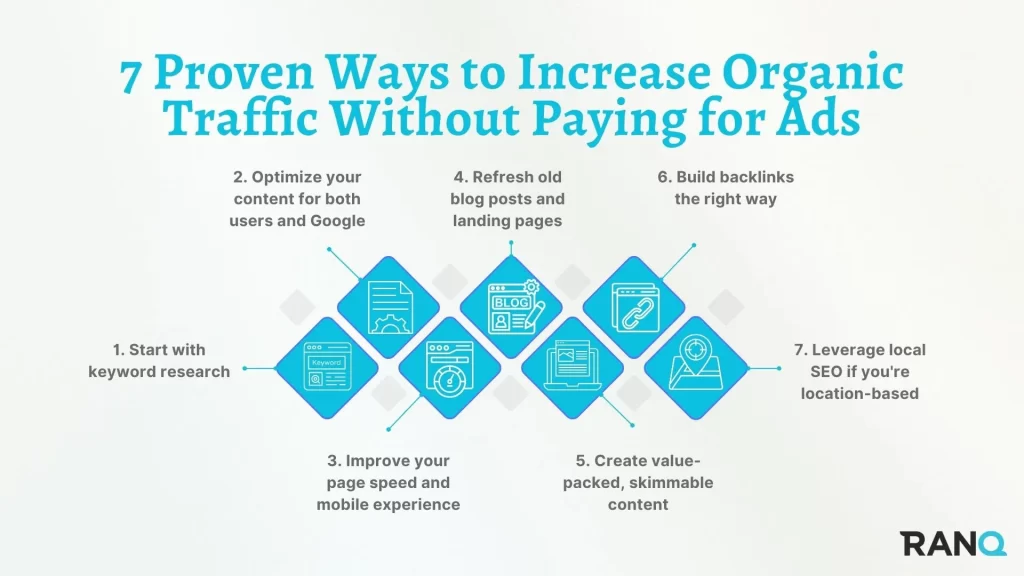As a small to medium-sized business, you’re faced with so many options for marketing, but it’s easy to forget the importance of organic traffic. Every social media site and search engine may offer opportunities for paid ads, but organic traffic is unique in that it compounds over time if your strategy is right.
In this guide, we’ll walk through beginner-friendly steps to increase your traffic without spending on ads by taking advantage of SEO practices, content improvements, and technical fixes. With a few purposeful changes, you’ll be moving up in the ranks on search engines and showing up on radars for entirely new local and national audiences.
Why Organic Traffic Matters (Especially for Small Businesses)

Whatever your expertise and size, you’re always going to be up against competition. That’s why optimizing your site for increased organic traffic matters so much. You’ll gain an advantage over your local competitors and capture the attention of visitors who are urgently searching for solutions to their problems.
Organic traffic is sustainable and cost-effective
Pay-per-click (PPC) advertising on social media and Google Ads may be appealing for its immediacy. Still, their marketing impact will disappear the moment you stop spending money on them. Organic traffic, on the other hand, is a sustainable and cost-effective investment that relies on the firm foundation of your website to extend your business’s reach and cement your authority.

Compare that to social media PPC ads, which account for only 5% of site traffic. That’s a massive difference, and one that illustrates the importance of search engine visibility and why Google values optimized, reliable content. A fact that’s only reinforced by how they increasingly reward content that’s helpful and insightful with higher search engine rankings.
You own the results, not the algorithm
Akin to PPC ads, advertising on platforms like Facebook or Instagram is visible only as long as you pour money into it. SEO benefits stick around and give you more control as a business over your visibility on SERP pages, especially when you can survey both your competitors and the search engine’s priorities and adjust your approach.
When you invest in strong content that leverages comprehensive SEO practices, you are creating long-term protection against algorithmic volatility. Instead of rewriting the content every time, you’ll be able to focus on maintenance and optimization.
Why organic traffic is a trust signal
Even the most well-crafted paid ads are at an immediate disadvantage compared to organic searches. With paid ads, audiences are keenly aware that they’re being sold to, and are more likely to be suspicious about a business if they aren’t already annoyed by repeatedly seeing the same ad. Conversely, organic searchers aren’t just browsing online; they are actively looking for solutions to tangible issues they want to be solved.

The data bears that out as well, considering that 75% of organic searches never even make it to the second page of Google’s SERPs. If you need assistance with raising your search engine visibility, look into Ranq’s services.
7 Proven Ways to Increase Organic Traffic Without Paying for Ads

Paid ads may seem like the easy way to boost your business, but there are many other ways to increase your organic traffic. In the next section, we’ll outline seven proven ways.
1. Start with keyword research
Keyword research is the SEO practice of identifying the words and phrases that people use on search engines like Google. By learning these words and phrases, you can better understand the way the customer thinks and also seek out the words and phrases that are less used or missed by competitors. Here are some suggestions:
- Start your keyword research by using tools like Google Keyword Planner, Ahrefs, or Semrush. We’ll broadly discuss how to use each:
- Google Keyword Planner – There are two main options here: search and “discover new keywords,” or upload existing keywords to “get search volume and forecasts.” When you choose the “discover new keywords,” you can either plug in words related to your industry or start with a website for which you want related keywords. From there, you’ll have a long list of related keywords that you can start analyzing to see which keywords have the lowest search volume.
- Ahrefs Free Keyword Generator – Search for any term, and you’ll be able to see dozens of popular related keywords and relevant questions. Each keyword has an indicated keyword difficulty ranking.
- Semrush Keyword Magic – Search any word or phrase to show thousands of related keywords with keyword difficulty
- Try to come up with a list of about 10 keywords that are relevant to your business. Target long-tail (three to five words), low-competition keywords to bring in more niche but high-intent searchers.
- After picking keywords, look at the top 3-5 SERP results and note patterns in content and subject matter (e.g., list posts, FAQs).
- Match keywords with common actual customer questions related to your area of expertise.
- Semrush can also help with competitor analysis, showing you shared keywords on those websites.
- Look at what Google is ranking highly and reverse-engineer the structure and intent for your own content.
2. Optimize your content for both users and Google

Once you’ve decided on the right keywords, it’s not as simple as crafting content with the keywords in the title (although that is relevant) to optimize the content. Here are some things to consider:
- Keywords should be present throughout the content, including the title, headers, body, and alt text.
- Make sure to leave room for links to other parts of your website, especially if you’ve made content specifically about that subject.
- Use bullets, clear headings, and short paragraphs. Attention spans aren’t infinite; keep potential customers on your page.
3. Improve your page speed and mobile experience
Optimizing your website doesn’t only focus on content. It’s also about modifying your website to improve performance and responsiveness. To improve your page speed and mobile experience, there are minor adjustments you can make, such as reducing the number of HTTP requests and compressing images to minimize third-party scripts. However, there are also many more involved processes that you may want to leave to the professionals.
Core Web Vitals are a set of three metrics that gauge real-world user experience with a website, and can impact your search engine rankings in Google. The three metrics focus on loading, interactivity, and visual stability of your website. The three metrics are:
- Largest Contentful Paint (LCP) – A measurement of how quickly the main content of a website becomes visible to users.
- Interaction to Next Paint (INP) – A measurement of how quickly a website responds to user interactions like clicks or key presses.
- Cumulative Layout Shift (CLS) – A measurement of how much your website layout moves when loading a page.
Each of these vitals requires different, advanced steps to fix if they’re not performing up to expectations, but first, you should test your website with Google PageSpeed Insights or GTmetrix. Both of these tools can break down your website’s performance and provide an easy-to-read report.
4. Refresh old blog posts and landing pages
Another useful optimization tool is Google Search Console. This service allows you to measure your website’s search traffic and performance metrics, including impressions, clicks, search engine rankings, and average click-through rate. Through these measurements, you’ll also be able to identify declining performance pages.
Those pages may need updated statistics, optimized headers, or broken links to be fixed. Still, some may require more extensive changes, such as adding relevant FAQs or Schema Markup, to provide search engines with additional information about a page.
5. Create value-packed, skimmable content
Your content doesn’t need to be novel-length to be valuable. Here are some tips for tuning your website posts:
- Your most visible content needs to be crafted with readability in mind. Bullet points, short paragraphs, and headings help break up the content.
- Your content needs to solve a clear problem that the reader would have.
- Make it visually appealing – insert infographics, videos, and other relevant charts.
- Every time you revamp your content, you can help it perform better.
6. Build backlinks the right way
One of the best indicators of trust on your website for Google is the presence of backlinks (links from other sites back to your site). By building quality backlinks, you can rank higher in organic search results and draw more organic traffic from links on other sites. Ideally, you should be able to earn backlinks from your regular blog content as you write about topics that interest other content creators or businesses and reach broader audiences through SEO practices.
One thing to keep in mind is that you’re always thoughtful about backlinks. They may be a sign of trust to Google, but make sure that your customers don’t think that you’ve taken to spammy tactics with all the new backlinks. Be sparing with your links, and go for quality over quantity.
Beyond social media, there are multiple other methods you can use to earn backlinks, including leveraging guest posts from relevant businesses, digital PR like affiliates, or filling out industry/region-specific directories. However, you want to gain backlinks, ensure that this content comes from adjacent brands or thought leaders who can increase your authority.
7. Leverage local SEO if you’re location-based
Competition is inevitable, national or local, but there are a few local SEO tasks you can use to get a leg up on your competition. When trying to attract local customers, an optimized Google Business Profile is a crucial move. It’s also a later effective place to showcase reviews from those satisfied local customers.
This profile is a verification method for your business that works with Google Maps and the search engine function. It also serves as a digital trust signal for both Google and potential customers.

(Source Google)
When optimizing your profile, also include local keywords and service pages. Part of the appeal of local SEO, besides its convenience, is that the business feels part of the community. Own that detail and you’ll see more organic traffic.
Organic Growth Takes Time, But It’s Worth It
Gaining organic traffic from SEO practices won’t be instant, but it builds momentum and stability in a way that paid ads will never be able to. At the beginning, find value in the little things: see how you can rank highly for niche keywords in your industry, improve your old content, and earn backlinks from satisfied customers and readers. For all your ongoing optimization and content upgrade needs, hire Ranq.


